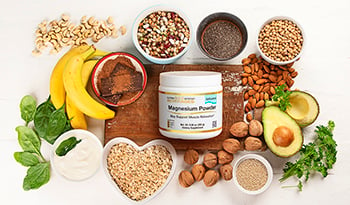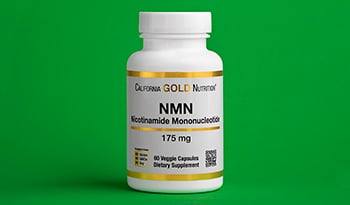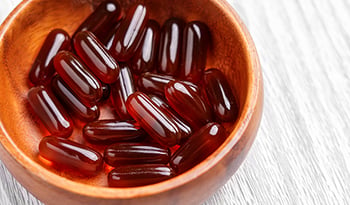Why Palmitoylethanolamide (PEA) Is Important for Your Health

Palmitoylethanolamide, or PEA, has various health benefits, from reducing inflammation and pain to gut and anti-aging benefits. In this article, we will explore how PEA works, the health benefits of PEA, how you can ensure you are getting enough in your diet and whether to consider supplementing.
What Is Palmitoylethanolamide (PEA)?
Palmitoylethanolamide is a fatty acid that is found naturally throughout the body. It may play a role in various biological processes, specifically in the Endocannabinoid System (ECS).
The body produces higher amounts of PEA in the presence of physical and mental stress. Infection, pain, allergens, toxins, UV damage, pesticides, glutens, and carcinogens can also trigger its production. Not surprisingly, Palmitoylethanolamide has anti-inflammatory and pain-fighting properties and is being investigated as a treatment for various conditions.
Specifically, palmitoylethanolamide has been shown to have nerve-protecting effects and may help treat neurological disorders.
How Does Palmitoylethanolamide Work?
The mechanisms by which palmitoylethanolamide might work have yet to be fully understood. Still, we have made a lot of progress thanks to Professor Rita Levi-Montalcini, who clarified the mechanism of action between 1992-1996. She went on to study PEA for neuropathic pain and allergies.
PEA is believed to do four main things:
- Reduce inflammation.
- Reduce mast cell activation (allergies).
- Enhance ECS activity.
- Activate specific receptors in the body.
Food Sources of Palmitoylethanolamide
PEA is produced naturally by all cells of the human body. It is made at higher levels during times of physical stress. However, Palmitoylethanolamide (PEA) is in various foods, such as:
- Egg yolk
- Peanuts
- Soy Lecithin
- Soybeans
- Lentils
- Garden peas
- Tomatoes
- Corn
- Cow milk
Health Benefits of Palmitoylethanolamide
Pain and Inflammation
Chronic pain is a serious problem worldwide and will continue to be an issue with the aging of the population. One of PEA's functions is to help regulate pain and inflammation. PEA interacts with CB1 and CB2 receptors, which are part of the endocannabinoid system. This system is responsible for maintaining homeostasis or balance in the body.
Endocannabinoids are released by the body to help control the immune response when there is an injury or inflammation. PEA helps increase the levels of endocannabinoids in the body, ultimately leading to reduced pain and inflammation.
In addition, PEA reduces the release of inflammatory chemicals and reduces overall nerve inflammation. These effects make PEA a possible tool for helping control pain and inflammation. Studies show PEA may also be useful for sciatica and carpal tunnel syndrome.
Clinical studies have shown that PEA effectively treats pain associated with various conditions, including neuropathic pain, fibromyalgia, migraines, and musculoskeletal disorders.
Joint Health
Osteoarthritis is a chronic condition that affects most people aged 50 and older. As time goes on, the amount the cartilage that cushions the joints breaks down. Living a healthy, active lifestyle can slow down this process. Fortunately, PEA may be one of those substances which can help reduce arthritis-related pain once it occurs. Studies show PEA may also be helpful in those with Rheumatoid arthritis.
PEA is found naturally in the body, and its levels increase when tissue damage occurs. PEA works by inhibiting the production of inflammatory mediators, such as cyclooxygenase-2 (COX-2) and interleukin-1β (IL-1β). Interestingly, this is similar to what anti-inflammatory medications like ibuprofen, ketoprofen, and diclofenac do.
Additionally, PEA has been shown to stimulate the production of anti-inflammatory factors, such as IL-10. The anti-inflammatory effects of PEA are thought to be mediated, at least in part, by activation of the peroxisome proliferator-activated receptor alpha (PPARα).
In animal models, PEA effectively reduces inflammation and pain associated with arthritis, traumatic injury, and surgery.
In human clinical trials, PEA treats chronic pain syndromes, such as fibromyalgia and low back pain[ix]. Additionally, PEA appears safe and well tolerated, with few side effects reported in the studies reviewed. Together, this data suggests that PEA may have therapeutic potential in treating arthritis conditions characterized by inflammation and pain. A 2021 study stated that PEA could be an effective treatment option for osteoarthritis.
Healthy Aging
The ability to slow down the aging progress is a worthy goal that many scientists worldwide have undertaken. PEA is believed to act as an anti-aging agent by helping to protect cells from damage caused by oxidative damage, which is a leading reason we age.
Oxidation occurs when cells are exposed to too much free radical activity, which can lead to premature cell death. The unhealthy foods we consume, the tobacco smoked, and other environmental exposures such as air pollution also promote oxidative damage. Palmitoylethanolamide helps to prevent this damage by scavenging free radicals and reducing overall inflammation in the body.
In addition, Palmitoylethanolamide has been shown to stimulate the production of collagen and other essential skin proteins. As a result, it may lessen the appearance of wrinkles and fine lines and protect the cells internally.
Anti-Allergy Properties
Allergic reactions are the immune system's response to a "perceived threat." Most of the time, they are an annoyance that results in itchy eyes, nose, or skin. Other times, allergic reactions can be life-threatening- as in the case of an anaphylactic reaction. When exposed to a trigger, the body releases histamines, which cause symptoms like itching, swelling, and increased mucus production.
Palmitoylethanolamide is thought to work by reducing the release of histamines from mast cells. In animal studies, palmitoylethanolamide was found to be effective for those with chronic skin itching due to allergies.
A 2008 study also showed improvement in eczema symptoms in those who applied PEA as a cream to their skin. The patients had less itchiness and, as a result, improved sleep.
Athletic Performance
In addition to BCAAs (Branched Chain Amino Acids), PEA has also believed to be effective in exercise recovery. The mechanism of action and how it helps athletes are not fully understood, but it is thought to work by reducing inflammation and promoting healing. According to a recent article, it also appears to stimulate muscle synthesis.
PEA supplements are well tolerated and have few side effects, making them a promising option for athletes looking to improve their recovery times. While more research is needed to determine the full extent of its benefits, PEA is a safe and effective way to reduce exercise-induced inflammation and promote muscle recovery and synthesis.
Brain and Cognitive Health
Keeping the brain healthy is vital to prevent chronic degenerative diseases and to help keep the memory sharp.
Palmitoylethanolamide (PEA) is a natural fatty acid made in the brain. PEA has anti-inflammatory and neuroprotective effects. PEA stimulates healthy brain cells and reduces inflammation in the brain. PEA also protects brain neurons from excitotoxicity, oxidative stress, and cell death induced by inflammatory mediators.
PEA has also demonstrated its usefulness in reducing inflammation and improving neurological outcomes in animal models of stroke, Alzheimer's disease, Parkinson's disease, infection, traumatic brain injury, and an autism spectrum disorder.
Specifically, a 2017 study concluded that a form of PEA "slowed down disease progression and disability in Parkinson's Disease patients.." In this study, patients were still on their usual medication for Parkinson's disease.
These findings suggest that PEA may be a promising therapeutic approach for treating neurodegenerative and neuroinflammatory disorders. More research, however, is needed before definitive conclusions can be made.
The Gut-Brain Axis
In the past decades, scientists have learned much about the importance of gut bacteria, the microbiome, and its role in one's overall health and well-being. A diverse gut microbiome helps ensure an intact gut barrier that helps keep harmful toxins from being absorbed into one's bloodstream, which can have adverse effects on one's brain and body.
Palmitoylethanolamide (PEA) also appears to play an essential role in keeping the gut healthy through its anti-inflammatory effects. Emerging evidence indicates that PEA may also play a role in gut health via the gut-brain axis (GBA).
PEAs' ability to prevent TRPV1 (a gut protein) activation may help to maintain gut barrier integrity. When this unique gut protein is triggered, it results in increased intestinal permeability, contributing to a "leaky gut."
According to studies, PEA can be helpful for those who have a leaky gut, a condition where the gut barrier is impaired. A Leaky gut has been associated with migraines, fibromyalgia, arthritis, auto-immune conditions, and more.
Lastly, PEA's ability to reduce inflammation via multiple targets makes it a promising candidate for treating inflammatory gut diseases, such as inflammatory bowel disease (IBD). IBD is a chronic inflammatory disorder of the gastrointestinal tract that affects millions worldwide.
Current treatments for IBD focus on suppressing the immune response; however, these treatments often have limited efficacy and are associated with significant side effects. A 2015 animal study showed that PEA could help reduce intestinal inflammation. Lastly, a 2021 study also showed the benefits of PEA in reducing colon inflammation.
Migraines
Migraines, often experienced as painful, throbbing headaches and sometimes causing nausea and light sensitivity, affect 1 billion people worldwide. Some studies suggest that one in seven people will experience this severe headache at some point in their life—almost one in five women and one in 15 men.
PEA effectively reduces pain during migraine headaches. The mechanism of action of PEA in migraine is not entirely clear, but it is thought to involve the regulation of inflammatory mediators, such as prostaglandins and cytokines.
In a 2022 study 25 patients (22 women, 3 men) with migraines were given PEA. The number of days with headaches decreased from 10 per month to 6.6 days per month. Pain medication use also was reduced. There were no adverse side effects. The authors concluded that PEA could be useful in treating and preventing migraines. Lastly, a 2020 study of children also showed benefits in treating migraine headaches with PEA.
Other Uses
Studies have also shown PEA could be useful for Depression, Anxiety, Fibromyalgia, Ulcerative Colitis, stroke recovery, and Irritable Bowel Syndrome.
Safety
There are no known drug interactions. This supplement is generally safe for children, adults, seniors, and athletes. Consult with your physician if you have any questions.
Suggested Dosage
400 to 600 mg once or twice per day.
References:
- Rankin, L., & Fowler, C. J. (2020). The Basal Pharmacology of Palmitoylethanolamide. International Journal of Molecular Sciences, 21(21), 7942. https://doi.org/10.3390/ijms21217942
- Landolfo, E., Cutuli, D., Petrosini, L., & Caltagirone, C. (2022). Effects of Palmitoylethanolamide on Neurodegenerative Diseases: A Review from Rodents to Humans. Biomolecules, 12(5), 667. https://doi.org/10.3390/biom12050667
- LoVerme, J., La Rana, G., Russo, R., Calignano, A., & Piomelli, D. (2005). The search for the palmitoylethanolamide receptor. Life Sciences, 77(14), 1685–1698. https://doi.org/10.1016/j.lfs.2005.05.012
- Clayton, P., Hill, M., Bogoda, N., Subah, S., & Venkatesh, R. (2021). Palmitoylethanolamide: A Natural Compound for Health Management. International Journal of Molecular Sciences, 22(10), 5305. https://doi.org/10.3390/ijms22105305
- Artukoglu BB;Beyer C;Zuloff-Shani A;Brener E;Bloch MH. (2017). Efficacy of Palmitoylethanolamide for Pain: A Meta-Analysis. Pain Physician, 20(5). https://pubmed.ncbi.nlm.nih.gov/28727699/
- Keppel Hesselink, J., & Kopsky, D. (2015). Palmitoylethanolamide, a neutraceutical, in nerve compression syndromes: efficacy and safety in sciatic pain and carpal tunnel syndrome. Journal of Pain Research, 729. https://doi.org/10.2147/jpr.s93106
- D’Amico, R., Impellizzeri, D., Cuzzocrea, S., & Di Paola, R. (2020). ALIAmides Update: Palmitoylethanolamide and Its Formulations on Management of Peripheral Neuropathic Pain. International Journal of Molecular Sciences, 21(15), 5330. https://doi.org/10.3390/ijms21155330
- Gatti, A., Lazzari, M., Gianfelice, V., Di Paolo, A., Sabato, E., & Sabato, A. F. (2012). Palmitoylethanolamide in the Treatment of Chronic Pain Caused by Different Etiopathogenesis. Pain Medicine, 13(9), 1121–1130. https://doi.org/10.1111/j.1526-4637.2012.01432.x
- Passavanti MB, Fiore M, Sansone P, Aurilio C, Pota V, Barbarisi M, Fierro D, Pace MC. The beneficial use of ultra micronized palmitoylethanolamide as add-on therapy to Tapentadol in the treatment of low back pain: a pilot study comparing prospective and retrospective observational arms. BMC Anesthesiol. 2017 Dec 19;17(1):171.
- Gabrielsson, L., Mattsson, S., & Fowler, C. J. (2016). Palmitoylethanolamide for the treatment of pain: pharmacokinetics, safety and efficacy. British Journal of Clinical Pharmacology, 82(4), 932–942. https://doi.org/10.1111/bcp.13020
- Jung JI, Lee HS, Jeon YE, Kim SM, Hong SH, Moon JM, Lim CY, Kim YH, Kim EJ. Anti-inflammatory activity of palmitoylethanolamide ameliorates osteoarthritis induced by monosodium iodoacetate in Sprague-Dawley rats. Inflammopharmacology. 2021 Oct;29(5):1475-1486.
- Morsanuto V, Galla R, Molinari C, Uberti F. A New Palmitoylethanolamide Form Combined with Antioxidant Molecules to Improve Its Effectiveness on Neuronal Aging. Brain Sci. 2020 Jul 17;10(7):457.
- Esposito E;Cuzzocrea S. (2013). Palmitoylethanolamide is a new possible pharmacological treatment for the inflammation associated with trauma. Mini-Reviews in Medicinal Chemistry, 13(2). https://pubmed.ncbi.nlm.nih.gov/22697514/
- Vaia M, Petrosino S, De Filippis D, Negro L, Guarino A, Carnuccio R, Di Marzo V, Iuvone T. Palmitoylethanolamide reduces inflammation and itch in a mouse model of contact allergic dermatitis. Eur J Pharmacol. 2016 Nov 15;791:669-674. doi: 10.1016/j.ejphar.2016.10.005. Epub 2016 Oct 5. PMID: 27720681.
- Eberlein B, Eicke C, Reinhardt HW, Ring J. Adjuvant treatment of atopic eczema: assessment of an emollient containing N-palmitoylethanolamide (ATOPA study). J Eur Acad Dermatol Venereol. 2008 Jan;22(1):73-82. doi: 10.1111/j.1468-3083.2007.02351.x. PMID: 18181976.
- https://www.nutraingredients-asia.com/News/Promotional-Features/Palmitoylethanolamide-is-the-new-solution-for-athletes-and-ageing-muscles
- Mallard A, Briskey D, Richards A, Mills D, Rao A. The Effect of Orally Dosed Levagen+™ (palmitoylethanolamide) on Exercise Recovery in Healthy Males-A Double-Blind, Randomized, Placebo-Controlled Study. Nutrients. 2020 Feb 25;12(3):596.
- Roncati, L., Lusenti, B., Pellati, F., & Corsi, L. (2021). Micronized / ultra micronized palmitoylethanolamide (PEA) as natural neuroprotector against COVID-19 inflammation. Prostaglandins & Other Lipid Mediators, 154, 106540. https://doi.org/10.1016/j.prostaglandins.2021.106540
- Brotini S, Schievano C, Guidi L. Ultra-micronized Palmitoylethanolamide: An Efficacious Adjuvant Therapy for Parkinson's Disease. CNS Neurol Disord Drug Targets. 2017;16(6):705-713.
- Couch DG, Cook H, Ortori C, Barrett D, Lund JN, O'Sullivan SE. Palmitoylethanolamide and Cannabidiol Prevent Inflammation-induced Hyperpermeability of the Human Gut In Vitro and In Vivo-A Randomized, Placebo-controlled, Double-blind Controlled Trial. Inflamm Bowel Dis. 2019 May 4;25(6):1006-1018.
- Borrelli F, Romano B, Petrosino S, Pagano E, Capasso R, Coppola D, Battista G, Orlando P, Di Marzo V, Izzo AA. Palmitoylethanolamide, a naturally occurring lipid, is an orally effective intestinal anti-inflammatory agent. Br J Pharmacol. 2015 Jan;172(1):142-58. DOI: 10.1111/bph.12907. Epub 2014 Dec 1. PMID: 25205418; PMCID: PMC4280974.
- Esposito G, Pesce M, Seguella L, Lu J, Corpetti C, Del Re A, De Palma FDE, Esposito G, Sanseverino W, Sarnelli G. Engineered Lactobacillus paracasei Producing Palmitoylethanolamide (PEA) Prevents Colitis in Mice. Int J Mol Sci. 2021 Mar 14;22(6):2945.
- Hernández AG. Palmitoylethanolamide-based nutraceutical Calmux® in preventive treatment of migraine. Clin Neurol Neurosurg. 2022 Jul;218:107282.
- Papetti L, Sforza G, Tullo G, Alaimo di Loro P, Moavero R, Ursitti F, Ferilli MAN, Tarantino S, Vigevano F, Valeriani M. Tolerability of Palmitoylethanolamide in a Pediatric Population Suffering from Migraine: A Pilot Study. Pain Res Manag. 2020 Apr 24;2020:3938640.
DISCLAIMER:This Wellness Hub does not intend to provide diagnosis...
















































































 Table of Contents
Table of Contents
















